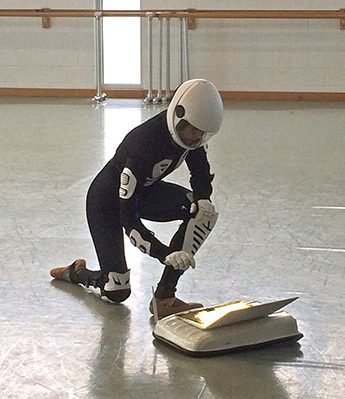Last fall, the intriguing final entry in the program for the Washington Ballet’s 2016-17 season — the company’s first under renowned former American Ballet Theatre principal dancer Julie Kent — was: “Tudor, Ashton and a World Premiere.”
The world premiere, the new artistic director’s first commission, turns out to be “Frontier,” choreographed by Kent’s one-time ABT colleague, star dancer, director and creator Ethan Stiefel, to music by Adam Crystal performed by the Washington Ballet Orchestra under conductor Martin West.
“Frontier” was commissioned as part of the ongoing JFK 100 centennial celebration. Sharing the bill on May 25, 26 and 27 at the Kennedy Center Opera House are two classic works by English choreographers: “Lilac Garden” of 1936 by Antony Tudor, set to music by Ernest Chausson, and “The Dream” of 1964 by Frederick Ashton, based on Shakespeare’s “A Midsummer Night’s Dream” and set to music by Felix Mendelssohn.
The combination reflects Kent’s season-long emphasis on the works of 20th- and 21st-century ballet’s most brilliant interpreters, including George Balanchine, Twyla Tharp, Jiří Kylián, Alexei Ratmansky, William Forsythe and the youthful (29) Justin Peck. At the same time, she did not forget to serve history, with a 40th-anniversary celebration, a “Nutcracker” and a “Giselle.”
We talked with Kent and her husband, Associate Artistic Director Victor Barbee, at the Washington Ballet studios earlier this spring, right after the last performance of “Giselle.” Both of them can talk about dancers because both of them have been — are — dancers, and a lot of love for the company comes through in that talk. “We are co-directors,” she said. They are partners, it’s pretty obvious.
“I think part of doing what we do is to build the foundation of a company, to bring people together,” Kent said, touching on the building-block theme, but also pleased with the way “Giselle” had turned out. “It was so good and everybody got better. That was very exciting.”
Interviewing Kent is always a pay-total-attention experience. She speaks quietly, but intently and intensely. She is intellectually comfortable with and articulate about the broad goals and ambitions she has for the company. Barbee shares the articulateness, but, dressed casually, gives off the aura of being a rock for her, disguised as a laid-back presence.
“It’s a puzzle,” Barbee said. ”You’re building with different sorts of pieces, to make a healthy design, and I think we need to do this now, today, more than ever.”
Which brings us to “Frontier.” Stiefel saw it as about space exploration. Kent saw larger artistic themes as well, and thought Stiefel embodied some of those themes. “He is an example of the American ability to develop and nurture artists with a unique sensibility,” she said.
Stiefel had apparently been on a cross-country motorcycle journey when tapped by Kent. “It’s such a big subject,” he said. “I wasn’t sure I wanted to do it at first, but then I started thinking about the whole thing in terms of the astronaut, in space. While we don’t exactly use space suits, we did have some technical help from suit designers. Dance is always about how people move through space — there you are — and I tried to imagine what that was like, alone and in tandem. It would be a little abstract and vivid and, yeah, a little out there, so to speak.
“We try to imagine the astronaut experience, what that is like. Kennedy called it the New Frontier. It’s gravity trying to transform humans. It’s what JFK also did, he asked us to consider the new frontier, which is, to me, using imagination. Dancers know something about discipline, training and so I can appreciate what they go through — the astronauts.
“I think initially I had about eight minutes, now it’s close to half an hour.”
Stiefel isn’t shy. He’s been a youthful director of the Royal New Zealand Ballet, he’s been in films, there are rumors female sighs could be heard when he danced with ABT. And there probably isn’t a dance figure quite so eclectic — smart, funny, a newlywed (to longtime girlfriend and fellow dancer Gillian Murphy), nurturer of a finely turned moustache like the villain’s in “The Prisoner of Zenda.” He’s very much the cool, 21st-century guy in the room.
Dance isn’t easy. “It’s a strain on the body. Your muscles take a beating all of the time,” he said. “But even sometimes, when you’re hurt, you go on to the next thing.”
The next thing. The New Frontier. Space, the final frontier, rockets thrusting into the dark in a burst of flame, calling it flight.
Earthbound, dancers are still perhaps the only human beings who can approximate flight, wingless but soaring. On earth, space is how you move through it. For astronauts, there is the grandeur of the ability to move toward it.


